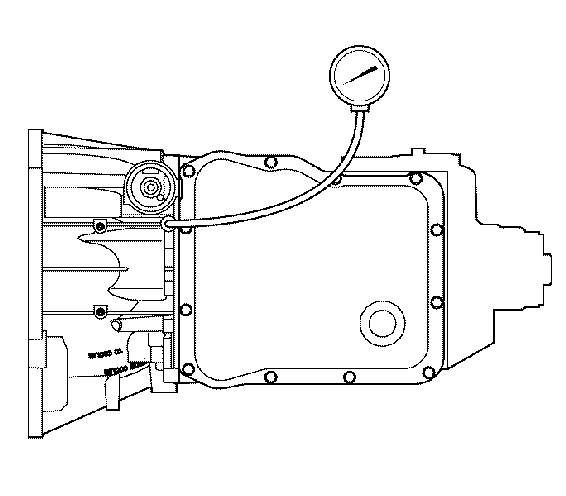
Checking main line pressure helps to determine if a transmission malfunction is due to a mechanical or an electrical condition. Properly making these pressure checks requires transmission and vehicle, or test stand, preparation, recording of data, and
comparing recorded data against specifications provided.
Caution: Keep the brakes applied at all times in order to prevent unexpected
vehicle motion. Personal injury may result if the vehicle moves unexpectedly.
- Remove the oil pressure tap plug. Refer to
Automatic Transmission Fluid Pressure Test Hole Plug Replacement
.
- Install
J 45056
pressure test adapter fitting prior to connecting the oil pressure gage.
- All transmission fluid level and pressure checks must be made at normal operating temperatures 71-93°C (160-200°F) sump; 82-104°C (180-220°F) converter-out. Check the transmission fluid level.
- Connect a 0-2070 kPa (0-300 PSI) oil pressure gage to the pressure test adapter fitting. Use the scan tool to check the engine RPM. Refer to
Line Pressure
for pressure level specifications.
- With the brakes applied, record the line pressure values at 600 RPM engine speed in NEUTRAL and REVERSE range. The transmission will be in converter mode, torque converter clutch not applied.
- With the brakes applied, record the line pressure values with the engine running at 2,100 RPM in NEUTRAL. The transmission will be in converter mode, torque converter clutch not applied.
- With the brakes applied, use the following scan tool settings to check pressures in FIRST through FIFTH gear ranges at 600 RPM. The transmission will be in converter mode, torque converter clutch not applied, at 600 RPM.
| 7.1. | Select F0: Diagnostics and press ENTER. |
| 7.3. | Select LDTrk, MPV, Incomplete. |
| 7.4. | Select F0: Powertrain, press ENTER. |
| 7.5. | Select Engine size, press ENTER. |
| 7.6. | Select 6 Speed Automatic, press ENTER. |
| 7.7. | Select F2: Special Functions, press ENTER. |
| 7.8. | Select F1: Transmission Output Controls. |
| 7.9. | Select Shift transmission. This will allow the technician to shift the transmission and check line pressure in each forward gear range. |
- Compare the data recorded to the line pressure specifications. Refer to
Line Pressure
.
- Disconnect the oil pressure gage and remove the
J 45056
pressure test adapter fitting.
- Install the oil pressure tap plug again. Refer to
Automatic Transmission Fluid Pressure Test Hole Plug Replacement
.

